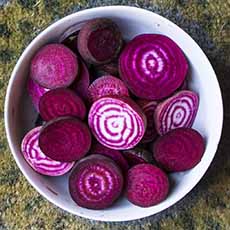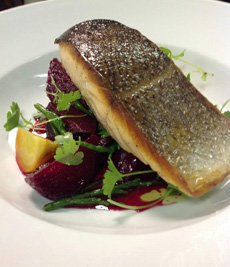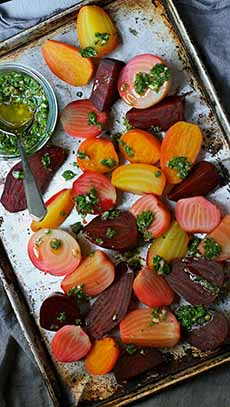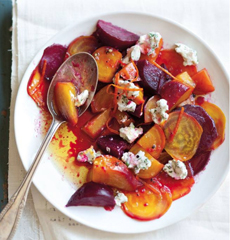|

[1] Beets are most familiar in a reddish-purple hue, but are also available in different shades of red, orange, white, yellow, even red with a red and white bullseye pattern inside, called chioggia [KYO-gee-a] beets (photos #1 and #4 © Quinciple).

[2] Chioggia beets (photo by Woodley Wonderworks | CC-By-2.0 License).

[3] Roasted salmon on a bed of beets (photo © Silk Road Tavern | NYC [since closed]).

[4] Roasted beets, easy and delicious, with chimichurri sauce.

[5] Beet guacamole (photo © Colette | Food Deco).

[4] Roasted red and yellow beets with goat cheese. Here’s the recipe (photo © Williams Sonoma).
|
|
Beets are one of those ‘em or hate ‘em foods. But they’re so delicious, we can’t understand the haters.
July 9th is National Beet Day, but we enjoy beets year-round. We eat the edible roots, and the greens are also delicious—just sauté or steam them. For fall, Valentine’s Day, or the holidays, the colors are perfect.
The availability of fresh, cooked, and canned beets makes it easy to incorporate beets into any meal. And unlike many canned or precooked vegetables, the flavor and texture are pretty close to fresh-cooked beets.
Today’s tip comes from Oldways, a not-for-profit whose mission is “to guide people to good health through heritage”: healthy eating and healthy foods that “have the power to improve the health and well-being of all of us.”
Along that line, beet roots deliver fiber, folate, manganese, and potassium; the beet greens pack vitamins A, C and K.
The history of beets is below.
BEETS FOR BREAKFAST
While it’s not a conventional breakfast ingredient, beets add vivid color, flavor and nutrition to:
Avocado toast: add sliced beets.
Bagel: with smoked salmon, cream cheese and sliced or julienned/matchstick beets. Add fresh dill for perfection!
Omelet: with diced or julienned beets.
Vegetarian “Eggs Benedict”: substitute a beet slice for the Canadian bacon.
Yogurt or cottage cheese: top with a small dice or blend with beets and fresh dill.
BEETS FOR LUNCH
Salad: add to side salads and luncheon salads (our favorite: beets, goat cheese and toasted walnuts on arugula or mesclun, and “purple potato salad”—the beets impart a swirl of color).
Sandwich: sliced plain or pickled beets on the sandwich, in a wrap or as a side.
Sandwich spread and more: blend horseradish and cooked grated beets into Greek yogurt to create a spicy sandwich spread, dip, or sauce for fish and meats.
Soup: hot or cold borscht.
BEETS FOR DINNER
First course: sliced oranges and beets on a bed of lettuce with vinaigrette or a drizzle of basil olive oil, or this beautiful galette.
Salad: grate over a green salad with finely sliced red onion and a red wine vinaigrette, add to a fall salad with roasted squash and fennel (recipe).
Garnish: add sliced, diced or in matchsticks, beets add pizzazz.
Beet mashed potatoes: recipe.
Grains: stir chopped roasted beets, crumbled feta and finely chopped beet greens into cooked farro, quinoa or brown rice; drizzle with extra virgin olive oil and lemon juice.
Roast vegetables: beets with carrots, parsnips, sweet potatoes, turnips, with fresh rosemary, crushed garlic, and extra virgin olive oil.
Sautéed beet greens: cook in olive oil with sliced onions, crushed garlic, red pepper and a pinch of chili flakes and salt.
Braised: cook sliced beets, sliced red cabbage and beet greens with a bit of apple cider vinegar and caraway seeds.
Cheese plate: pickled beets as a cheese condiment
You can add beets to breakfast bars, brownies, energy bars, sangria, smoothies. You can even make beet ice cream and a vegan beet “cheesecake.” See beautiful recipes at LoveBeets.com.
BEET HORS D’OEUVRE & SNACKS
Bruschetta: layer sliced beets on sliced baguette, top with Brie or other cheese, heat to slightly melt the cheese, garnish with fresh herbs.
Dip: blend beets into mayonnaise, plain yogurt or sour cream, with fresh dill;* or this beet dip and spread, or blend into white bean dip.
Beet hummus: recipe with pepper and recipe with ginger.
THE HISTORY OF BEETS
The modern beet (its botanical name is Beta vulgaris) evolved from wild sea beet, which grew wild in places as wide-ranging as Britain and India to Britain.
The wild sea beet was first cultivated in the eastern Mediterranean and Middle East—although only the leaves were eaten! (Even today, beet greens are delicious. Don’t throw them away: Sauté them.)
In early times, the medicinal properties of the root (the red bulb) led that portion to be used to treat a range of ailments from constipation, fevers, skin problems and wounds.
The Romans cultivated beets; early recipes included cooking beets with honey and wine (that’s still a good recipe today). Apicius, the renowned Roman gourmet, included a beet broth recipe in his cookbook as well as beet salad with a dressing of mustard, oil and vinegar.
The original beet roots were long and thin like carrots. The rounded root shape of today was developed in the 16th century and by the 18th century was widely cultivated in Central and Eastern Europe. Many classic beet dishes originated in this region, including borscht.
In 19th century England, beets’ dramatic color was popular to brighten up salads and soups. The high sugar content made it a popular ingredient in cakes and puddings.
Today there are many varieties of beets in sizes both large and small, including chioggia (with red and white concentric circles), orange, white and yellow. Look for these specialty beets in farmers markets.
_______________
*Or stir grated cooked beets, garlic, fresh dill or thyme, salt, pepper, and a squeeze of lemon juice into Greek yogurt.
|





